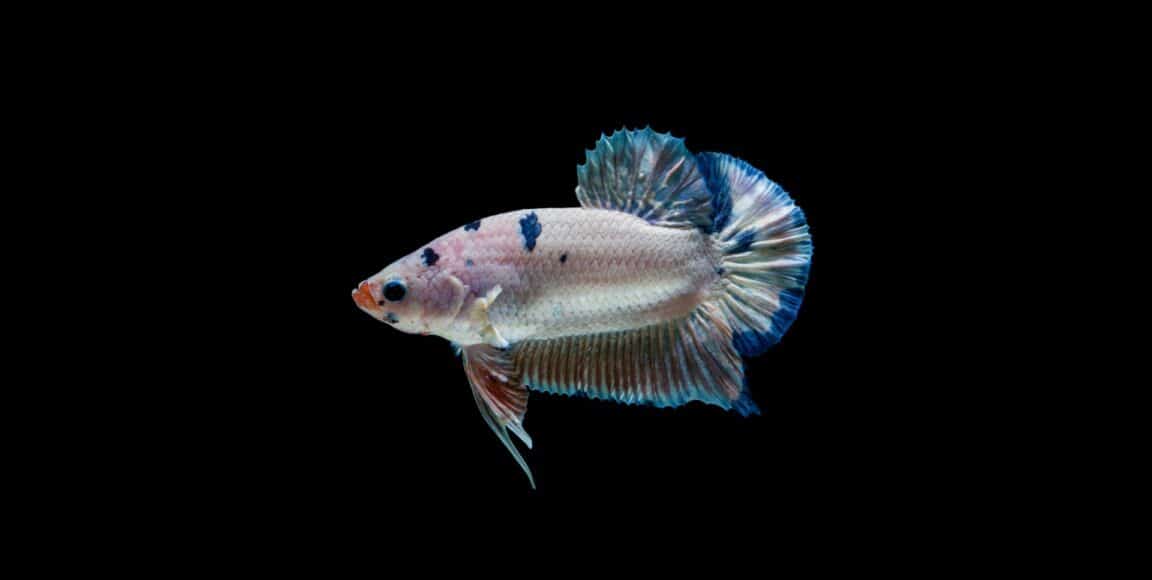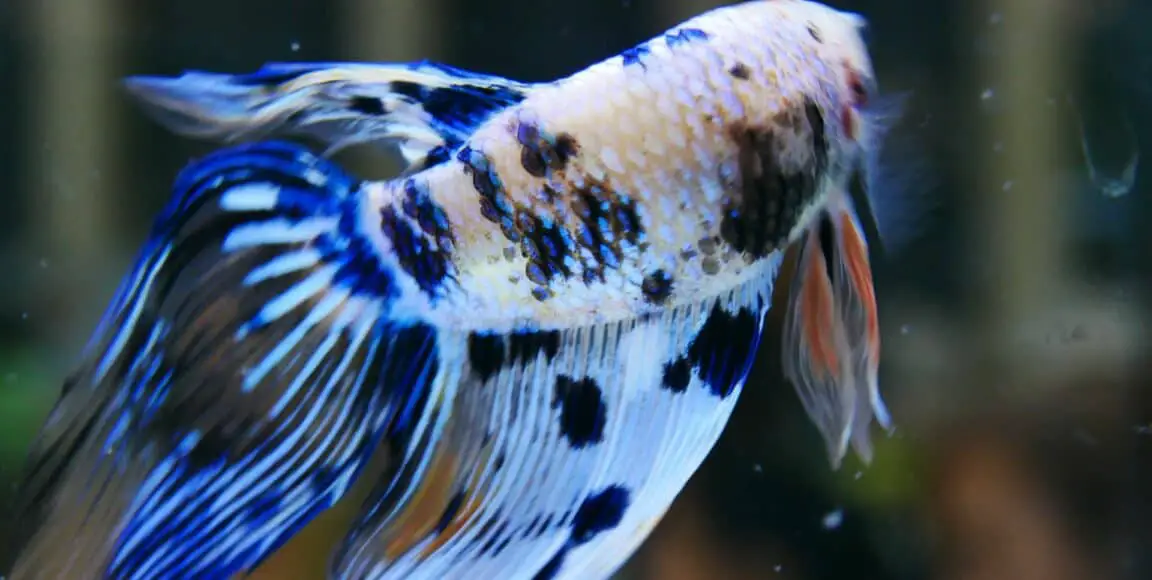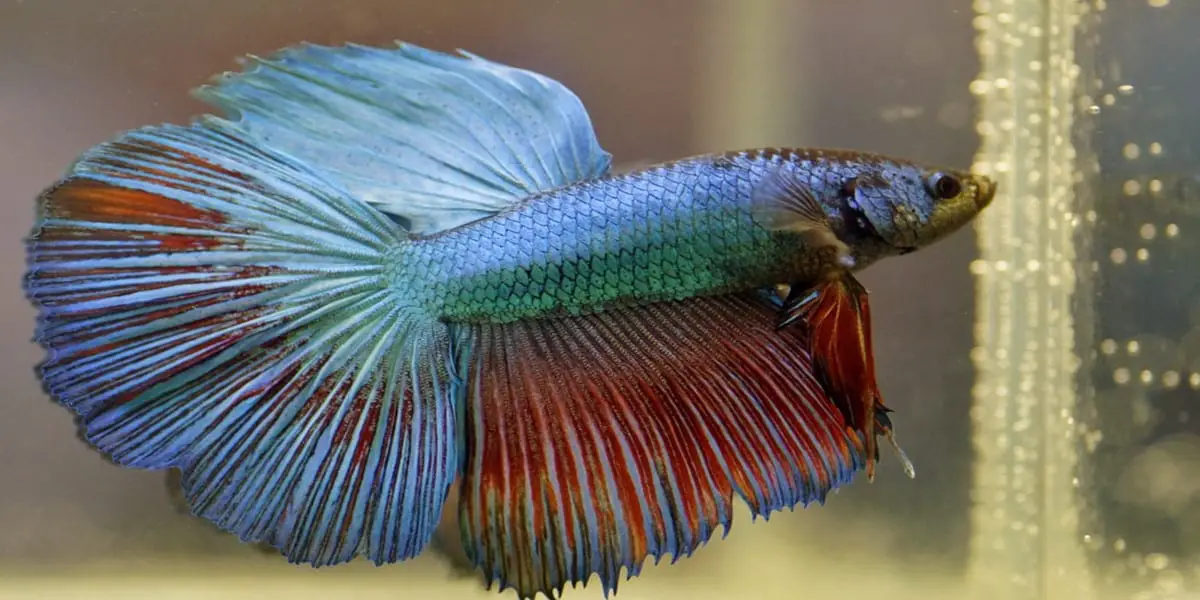Last Updated on February 14, 2023
Do you ever wonder what makes your betta fish change colors or why?
Siamese fighting fish, a.k.a betta fish, are known for their vibrant colors and striking prints that make them stand out.
But you might have noticed that your betta fish’s color have changed over time. And although it’s a natural trait of a betta, there are also some possibilities that other factors cause it.
In this article, we will answer these questions and discuss the factors that could affect why your betta fish change colors and whether it’s healthy.
Table of Contents
Why does betta fish change color?

There are many reasons why your betta fish is losing color.
If you notice your pet fish changes into white, black, or even lighter than their natural color, it may be because of the following:
Stress
When stressed, betta fish become highly susceptible to diseases and infections.
Besides a regular betta fish change in color, it can cause affect their behavior. For instance, they become lethargic or constantly hiding.
Physically, the betta’s color may start fading due to stress-induced pigment loss.
They may also develop “stress stripes,” which can be light to dark, ranging from white and red to black. Stress stripes can appear from the gill to the tail of your betta’s body.
The most common causes of betta fish stress are poor water quality and incorrect parameters such as pH, ammonia levels, and temperature.
Additionally, inadequate tank size can be very stressful for them and lead to betta fish turning white and aggression.
Other possible causes of stress are an overcrowded fish tank, major environmental changes, frequent tank transfer, and aggressive tank mates.
Age
The average lifespan of a betta fish is three to five years. And the color changes associated with age are usually noticeable when they turn 2-3 years old.
As betta fish get older, their color changes from the vibrant and intense hues of a very young betta fish to a duller shade. This change in color is caused by pigment loss due to age.
In addition, as betta age, their fins may become frayed and their bodies thinner. They’ll also start losing their form and their eyesight.
These signs will be accompanied by lethargy and loss of appetite.
In the end, due to age, betta fish losing color is a natural process. And there’s little that can be done to stop it.
However, taking proper care of your betta fish with regular water changes and a healthier diet can help extend the life of your fish and delay the onset of color fading.
Illness or disease
Another great reason for color change is when you have a sick betta fish.
Betta fish can suffer from a variety of fungal and bacterial infections, which can greatly affect their color.
These diseases and illnesses often cause white spots to appear on the betta’s body, making it look faded or discolored.
Here are some common illnesses that could affect your betta:
Ich
This also refers to white spot disease, where the parasite sticks to the betta fish’s body.
It covers the body, making your fish covered in white dust. This will cause irritation, itchiness, and discomfort.
Your betta fish may rub itself against objects in the tank to remove the parasite. They might also experience loss of appetite and clamped fins.
Remove your fish from the container and place it in a hospital tank for treatment. Increase the temperature slowly from 81-86F each day. Administer a teaspoon of salt per gallon of water and perform a 25-50% water change daily.
While Ich is easy to treat, remember that this could lead to your betta’s death if left untreated.
Related: How To Cure Betta Fish Ick The Right Way
Velvet
This parasitic disease covers your betta in yellow or gold-like dust.
In its struggle to fight the infection, your betta fish is producing extra mucus that results in this gold coating.
Besides betta fish losing color, it will also suffer from loss of appetite, lethargy, and clamped fins.
Once you notice the velvet, remove your pet fish from the container.
Remember that you must treat your betta fish home, first. A hotter, saltier, and dark environment weakens the parasite until it dies.
Treating velvet is similar to healing your betta from white spots disease. The only additional step is that you should dim your container during the whole treatment.
The parasite has chlorophyll in its cells, making them capable of photosynthesis.
Related: Betta Fish with Velvet: How to Treat and Prevent it
Fin Rot

Fin rot is a common condition in betta fish that affects their fins, leading to the fading or darkening of its color.
Additionally, the edges can also appear ragged or frayed.
The two most common causes of fin rot are environmental stress and poor water quality.
For instance, a sudden change in the temperature of your aquarium, high levels of ammonia or nitrate, or depression can all lead to fin rot.
Your betta fish can have a shortened lifespan and even death if left untreated. Other signs and symptoms include redness around the fins and an overall weakened appearance.
So if you suspect that your betta has fin rot, transfer it to a hospital tank that should not be over two gallons. Set it up and start medication.
The earlier you detect the condition, the easier it is to treat.
Related: A Helpful Guide to Betta Fin Rot Treatment
Columnaris
This is a bacterial infection, also known as the cotton wool disease.
Your betta will have white spots like ich, and they can have frayed and ragged fins like fin rot.
Other symptoms would be sores or ulcerations on the skin of your betta fish.
Unlike the others, the treatment for Columnaris is quite different.
Bacteria flourish in a warm environment, so adjust the temperature of your fish tank to about 75 degrees Fahrenheit.
Add a teaspoon of aquarium salt every five gallons and use medication from the pet store. Remember to also do 25% water changes daily.
Anchor Worms
These worms can cause your betta to turn white and are easily identified.
They are around ¾ inches long and look as if they split at the end. As a response, your betta may brush against things to remove the worms.
This can cause red spots and sores, so you must immediately work on the treatment.
Treatment for this is very hands-on, as you need to remove the worms with tweezers.
Work on it quickly and transfer your betta to a hospital tank to rest and recover. Add salt and medication from the pet store.
While this is rare, it does not mean your betta fish will not have it.
Marble bettas
Marble betta fish is a popular variation of betta species.

They are called “Marble Betta Fish” because their coloration is similar to that of marble – watery, random swirls and streaks covering their body.
But where did marble bettas come from?
Orville Gulley, a prison inmate, discovered the marble gene by accident in his attempt to create a black buttery betta.
He sent some of his fish to Walt Maurus, an IBC hobbyist and writer of books about betta and other breeders.
They loved the new strain and started breeding this new pattern. This eventually led to the emergence of the marble betta we know today.
Contrary to how they look, marble bettas are healthy.
It’s just that their unique color is caused by a gene mutation known as the “jumping gene.”
This gene can move between chromosomes and cause color changes throughout their lifespan.
But as exciting as this can be for caretakers, some marbled bettas can turn completely solid or lose their color.
Why is my betta fish turning black?
Were you surprised to see your betta fish turning black?
It’s normal for your betta fish to change color, especially if you own a marble fish.
As bettas age, they can also begin to darken or lighten in color. So you won’t have to worry unless there are other symptoms, like lethargy, loss of appetite, and hiding.
If you notice any behavior change along with the color changing to black, it could be due to high ammonia levels.
Ammonia is a toxic waste product and can lead to other health problems if not treated properly.
So make sure to monitor your water parameters closely, do a regular partial water changes, and keep an eye on your betta fish’s behavior.
How to make your bettas full of color?

Other than its natural cycle, you can improve the color of your betta fish. If you just bought a betta or recently observed it is losing its color, check on these steps:
Temperature
Bettas tend to become more vibrant when the water is around 78 and 80°F (25 – 27°C).
Lower temperatures can cause their colors to become less intense, and their fins may appear faded.
Additionally, bettas exposed to warmer temperatures for too long can suffer from stress and become pale or lighter in color.
To ensure that your betta is getting the perfect temperature, it’s best to include a water heater in your aquarium.
This will ensure that the water stays at a consistent temperature throughout the day.
It’s also important to use an aquarium thermometer so you can monitor and adjust the temperature as needed.
Lastly, don’t forget to monitor the environment outside your aquarium.
Areas near windows or vents can cause sudden temperature drops, making your betta less colorful.
Tank Size
Larger tanks tend to be better for their health and can also help keep their colors vibrant.
This is because they are less likely to experience temperature fluctuations when kept in larger tanks and have more space to explore and have an active lifestyle.
On the other hand, small tanks can experience drastic changes in temperature, which can cause stress and make your betta’s colors less vibrant.
In addition, a small container means you need to change the water regularly, which can be very stressful for your betta.
They don’t like being transferred frequently, which can also affect their color.
Make sure to put your betta fish in a tank that holds at least 5 gallons of water. Some owners might say that a 2.5-gallon tank is enough for one betta.
However, I’d still suggest that you invest in a 5-gallon tank as it will be beneficial in the long run.
Water condition
Ammonia, pH, and chemical levels are important factors in keeping your betta colorful.
These levels should remain low to ensure that your betta is not exposed to toxins or pollutants.
Perform regular water tests and partial water changes to make sure the tank’s conditions are safe and clean for your fish.
Also, use a filter in the aquarium to prevent the accumulation of ammonia and other toxins.
Betta Food
Feeding your betta the right food is important for keeping its color vibrant.
Choose foods high in nutritional value, such as frozen or freeze-dried shrimp, worms, and bloodworms.
Avoid feeding them too many commercial pellets or flakes, as these lack the necessary vitamins and minerals to keep their colors.
In addition, keep a strict schedule for feeding your betta to prevent overfeeding.
A single betta should be fed no more than two times a day, and each meal should be small enough that they can finish it in two minutes or less.
Filters and Plants
Adding live plants and a filter to your betta’s tank can also help keep the water clean and their colors vibrant.
Live plants provide oxygen and create a natural environment, while filters reduce ammonia levels and keep the water clean.
This will give your betta the perfect environment to stay active and healthy, resulting in vibrant colors.
Tankmates
Separate male and female bettas to prevent fighting unless you are breeding.
Additionally, never put two males in the same tank, as they are likely to fight each other.
If you plan to add other fish species to your betta’s tank, make sure they are compatible and won’t stress out or harm your betta.
Find out other fishes you can put with your betta.
FAQs
Is it normal for betta to change color?
Yes, betta fish can change color over time as they grow and mature. This is due to a variety of factors, such as the environment they are kept in, the food they eat, and their genetics. Generally speaking, younger bettas tend to be more vibrant in color compared to older ones.
Do bettas lose color when stressed?
Yes, bettas can lose color when they are stressed. Stress can cause a decrease in the intensity of their colors and make them more prone to diseases and other health problems.
How do I get my betta fish color back?
You can help get your betta’s color back by providing a healthy environment.
This includes ensuring optimal water temperature and quality and providing plenty of hiding spaces like plants or caves.
You should also make sure to feed your betta a balanced diet with high-quality food.
Finally, try to reduce any sources of stress in its environment and give them plenty of time to rest and relax.
Why does my betta fish look pale?
Stress is one of the most common reasons, as it can cause a drain in the intensity of their colors and make them more prone to diseases and other health problems.
Low oxygen levels or poor water quality in their environment can also be contributing factors.
Additionally, they may simply lack the necessary pigments in their diet to stay vibrant and colorful.
Conclusion: Betta fish changing color
So when someone asks, “Do betta fish change color?” you know what to say.
While betta fish naturally improves its color as it grows, some factors can cause it to lose its vibrance.
Being observant is important for knowing if something’s up with your fish, but sometimes, we need minor adjustments to work out.
Keep in mind that a good environment will translate into good-looking and healthy fish!
